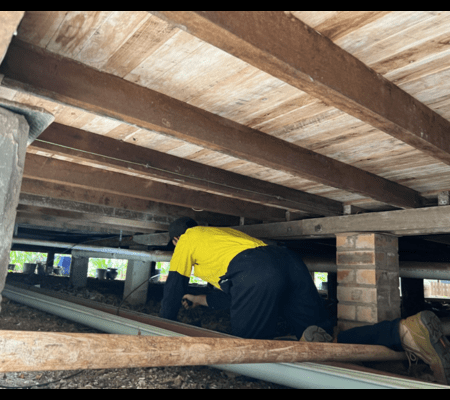The Environmental Impact of Termite Control
Termites cause damage and destruction in the human world. However, do they have no importance in the environment? It would be grossly unjust to overlook the positive impact of termites on the environment. As an experienced termite and pest expert, we have witnessed the remarkable environmental consequences that these creatures can bring about. In this extensive exploration, we’ll delve into the multifaceted environmental impact of termites, uncovering why they pose a threat to homeowners and the delicate balance of ecosystems.
If your property is infested by Termites then get them removed as soon as possible. They could lead to major financial losses if left unchecked. Get the best termite treatment in Logan and other locations serviced by Bob Gunn.
Structural Damage
Termites Inflicting Structural Damage
Termites are commonly known for causing harm to man-made structures such as houses and other wooden buildings. If unchecked in towns and cities, they might end up damaging residential buildings, places of work, roads, and other amenities, hence calling for costly repair work.
Termites do not just affect single buildings, they also damage whole neighbourhoods and suburbs. In places where termite presence is high, towns suffer great financial difficulties because of possible harm.
Ecosystem Disruption
Impact on Forest Ecosystems
In addition to the fact that they play a crucial role in urban ecosystems, termites also serve an important function in forest ecology. Their job is to act as decomposers by breaking up dead plants and wood scraps on topsoil layers of forests. It’s through this that it helps in recycling nutrient-rich compounds or organic matter while promoting soil fertility and encouraging new plant growth, but sometimes they become too many, hence disrespecting the balance of nature in an area by destroying its balance of nutrient flow by allowing decomposition to go too far.
In tropical rainforests, termites play a vital role in maintaining biodiversity by recycling organic matter and creating microhabitats for other organisms. However, disturbances such as deforestation and climate change can exacerbate termite activity, leading to imbalances in forest ecosystems. Conservation efforts are crucial to preserving the delicate balance of these biodiverse environments.
Influence on Soil Health
Termites play a pivotal role in maintaining soil health by aerating and enhancing its structure. Their subterranean tunnels create pathways for water and air infiltration, promoting drainage and preventing waterlogging. Moreover, termite activity facilitates the incorporation of organic matter into the soil, bolstering its fertility and supporting plant vitality. Nonetheless, in agricultural regions, termites can pose a threat to crops by consuming plant roots and compromising agricultural infrastructure.
They also dig underground passages that serve as conduits for water to pass through easily, thereby reducing the chances of flood-like situations. In addition, termites help in mixing organic matter into the soil thus increasing its fertility and enabling plants to grow healthily.
Biodiversity Impact
Termites help the ecosystem in many ways. For example, they are an important food for birds, mammals and other insects and prey away from these so as to control their numbers, which makes sure that their numbers remain balanced at all times in nature. Conversely, overpopulation often subjects them to competing with other indigenous plants leading to decreased numbers as well as destabilisation of environments. Such disruptions reverberate throughout the food chain, exerting profound impacts on entire ecosystems.
Changes in termite abundance causing biodiversity loss have far-reaching consequences on the effectiveness and robustness of ecosystems. In the context of delicate ecosystems (e.g., wetlands or grasslands) reducing termite numbers may interrupt nutrient cycling and impair soil fertility which eventually affects plants and animals in interconnected ways. Maintaining equilibrium and flexibility of the ecosystem in response to environmental changes requires that greater emphasis is put on preserving natural termites and their species.
Contribution to Climate Change
The environmental footprint of termites extends to climate change. Termites are prolific methane producers, generating this potent greenhouse gas during cellulose digestion. While individual termites emit relatively modest quantities of methane, the cumulative emissions from expansive termite colonies, particularly prevalent in tropical regions, can be substantial. Consequently, termite activity contributes to the exacerbation of climate change, compounding its environmental toll.
Termites play an important part in how carbon moves around the world. They show us how everything in nature is connected, including the land and the climate. As the Earth gets warmer and habitats change, where termites live and how many there are could also change. This could affect how much greenhouse gases they release, which in turn affects the climate. Knowing about these changes is really important for figuring out what might happen with the climate in the future and finding ways to deal with it.
Economic Consequences
Termites also exact a significant economic toll besides their ecological associations. Worldwide, billions of dollars are spent annually on costs relating to termite damage in terms of repair, renovation as well as pest control in the Logan area. Furthermore, termite-induced degradation and destruction results in losses for timber and wood products industries. Thus, addressing the environmental impact of termites is not only necessary for ecosystems but also required to sustain a viable economy.
In regions where there are many termites, damage to property and infrastructure is not the only cost burden. From reduced income; damaged habitats; and a bad reputation for areas infested by termites, other sectors like property sales, agriculture, forestry as well and tourism can experience a drop in output.
Towards Sustainable Coexistence
Termites have far-reaching environmental implications, influencing ecosystem balance, soil health, plant communities, and wildlife populations. While they play essential roles in nutrient cycling and habitat creation, their unchecked proliferation can lead to disturbances that alter ecosystem structure and function. Understanding the environmental impact of termites is crucial for effective ecosystem management and conservation.
Know more about termite behaviour and methods of termite control, on the website of Bob Gunn, pest control for Logan.








